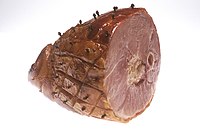
Photo from wikipedia
Penicillium nordicum is well known for its ability to produce high amounts of ochratoxin A (OTA) in cured meat-derived products. On the other hand, Aspergillus westerdijkiae, one of the most… Click to show full abstract
Penicillium nordicum is well known for its ability to produce high amounts of ochratoxin A (OTA) in cured meat-derived products. On the other hand, Aspergillus westerdijkiae, one of the most relevant OTA-producing species of the genus Aspergillus, is usually considered a major risk in carbon-rich food matrices of plant origin. The objective of this work was to evaluate, for the first time, the ecophysiological conditions governing growth, OTA production and sporulation of A. westerdijkiae (the type-strain and one ham-native strain), in comparison with P. nordicum, in dry-cured ham based medium. For that purpose, the interaction between temperature (15, 20, 25 and 30°C) and water activity (aw) (0.99, 0.97, 0.93, 0.90 and 0.85), achieved with a combination of ionic (NaCl) and non-ionic (glycerol) solutes, was studied by using dry-cured ham-based medium as a model system. Different OTA production profiles were found between the two genera, and also between the two strains of A. westerdijkiae, mostly in terms of amounts of OTA produced. The optimal OTA production conditions for A. westerdijkiae were at 0.94-0.97 aw and 20-25°C, and for P. nordicum at 0.95-0.97 aw between 18 and 22°C. Under these conditions, A. westerdijkiae produced 1934ng/g agar, while P. nordicum produced 712ng/g. None of the strains was able to produce detectable amounts of OTA at 0.85 aw, under all temperatures tested. Growth and sporulation were not good indicators of OTA production by A. westerdijkiae or P. nordicum. The results obtained show that A. westerdijkiae may represent a great potential risk of OTA contamination in dry-cured ham due to the high production under a wide range of conditions. Knowledge of the ecophysiology of important Aspergillus and Penicillium species and of their adaptability to the matrices can be determinant to adopt appropriate technological modifications during ham ripening process.
Journal Title: International journal of food microbiology
Year Published: 2017
Link to full text (if available)
Share on Social Media: Sign Up to like & get
recommendations!